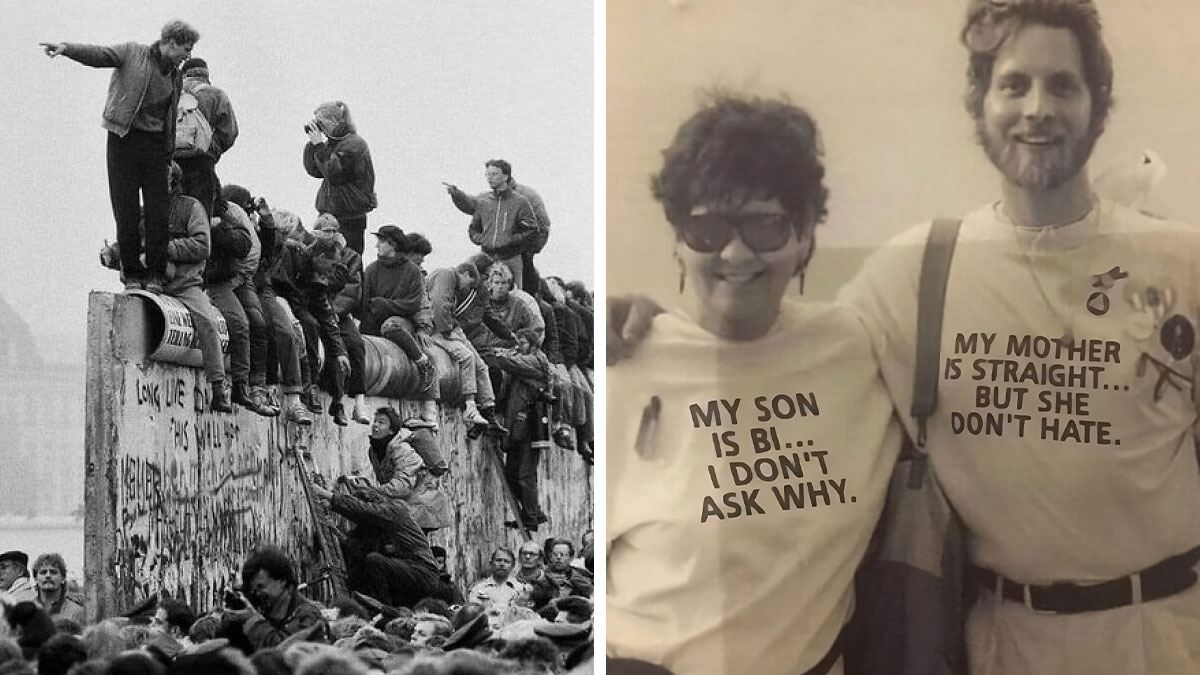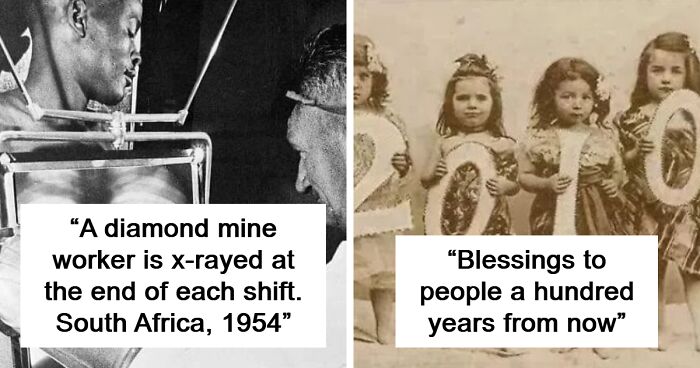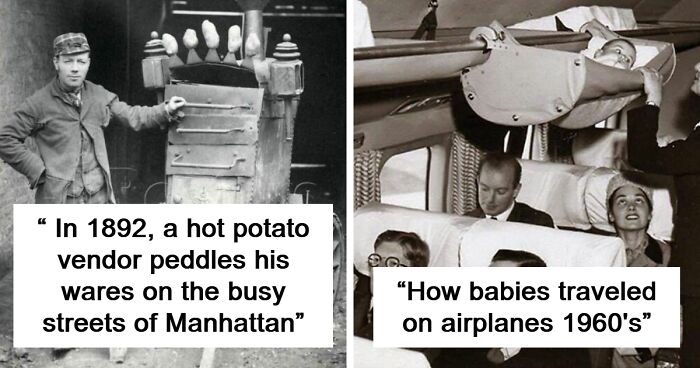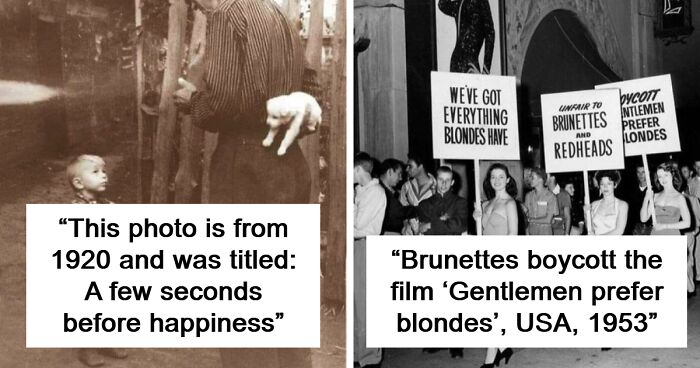
50 Interesting Historical Photographs That Might Teach You Something New
Interview With ExpertIt’s hard to pinpoint when humans started recording and sharing knowledge of the past. But it’s estimated that they started early on. At first, there were cave paintings, and then language, which allowed people to tell origin stories and pass them from generation to generation. The invention of writing systems allowed people to record the past more extensively. And as technology evolved, new ways of doing so emerged. Now, in addition to all of that, history can be recorded through photographs, video, and audio recordings.
Today we’ll be looking at our fascinating past through photography, courtesy of the Facebook group Historical Images. These pictures show what life was like before we came to this world and remind us that we and everything else exist because of those who came before us. Scroll down for a deep dive into our history and don’t forget to upvote the ones that resonated with you the most.
While you're at it, make sure to check out a conversation with Margot Note, expert archival consultant and founder of Margot Note Consulting LLC, who is passionate about preserving the past and kindly agreed to chat with us about historical pictures!
This post may include affiliate links.
This Photo Is From 1920 And Was Titled: "A Few Seconds Before Happiness"
Sitting On Their 1947 Chevrolet At Dinner, And 63 Years Later
In 1910, In New York, The United States, A Photographer Took A Photo Of Four Little Girls. Blessings To People A Hundred Years From Now
The keeping of written history records appears relatively late, only 5,000 years ago in Egypt and ancient Sumer. Before that, knowledge about the past would be passed on from memory, with ancient storytellers being able to recite stories for days.
"Before photographs, people recorded history through oral traditions, written records, visual depictions, and physical artifacts. Oral storytelling preserved myths, genealogies, and events in societies without writing, while early civilizations used cuneiform, hieroglyphs, and manuscripts to document their histories," further explained Margot Note, expert archival consultant and founder of Margot Note Consulting LLC, to Bored Panda.
"Visual methods included prehistoric rock art, detailed frescoes, and narrative tapestries like the Bayeux Tapestry. Historical records were also embedded in physical forms such as inscriptions on monuments, architectural achievements, and coins bearing rulers’ likenesses. Tools like the Inca’s knotted strings (quipu) and European chronicles showcased inventive ways to preserve memory. These methods reflect humanity’s enduring desire to document and interpret the past, paving the way for photography as a more permanent and detailed medium."
A Man Posing With A Donkey In His Lap, 1910s
Lucille Ball On The Day Of Her Wedding To Desi Arnaz, 1940
A Mother And Her Son On Their Way To A Pride Walk, 1985
History record-keeping picked up pretty fast and just within a few centuries we already had elaborate written chronicles. Written documents started to gain authority over oral stories because it was much harder to change them when they were written down.
Evidence also became important, as relying on what someone’s grandmother said to their dad didn’t cut it anymore. However, one downside to noting down the past at the time was that it only told the stories of the rich because most people still couldn’t read or write.
Saving Teddy During The 1941 Blitz Of Liverpool
Little Girl Talking With Her Father, A Train Driver For Southern Railway's Southern Belle Steam Train, Before He Leaves On A Trip To Brighton - London, 1931
Warsaw, Poland
Another interesting aspect of our history is that it only started to be precise and make chronological sense after the first ancient Olympic games in 776 BCE and the building of Rome in 753 BCE.
However, scholars have figured out various ways to precisely date events even before there were written records. Like finding radioactive materials to date objects such as bones or food remains.
Art was also very important in recording history. Many historical figures and events are immortalized in paintings and sculptures. However, until the advent of photography in 1826–27, people had to settle on seeing such images through the eyes of the artists who painted them, which might have been not entirely accurate.
Fall Of The Berlin Wall (1989)
"Historical" doesn't necessarily mean many years ago, it means events that are part of history. 9/11 is historical even though it's only 23 years later. 1989 is 35 years ago, in terms of years it's not that old, but the event itself is historical. I'm still in denial it was 35 years ago and I was an adult when it happened.
Load More Replies...Love how the B&W photo makes it look more like 1939! Seems bizarre to insert David Hasselhoff & electric guitars into this photo!
Hasselhoff in his blinking white light jacket. Awesome. Bringing the Cola Wars to the end of the Cold War.
Load More Replies...I remember watching this with my grandpa back in West Germany. He told me that it was the most important day of the 20th century.
I was there the year after it fell and parts of it were still up. I even got to keep a few small pieces of the wall.
A co-worker of mine happened to be in Berlin (west) at that time and brought back some pieces of the wall to give away. It was just a chunk of concrete that had some spray paint on it but what it represented was enormous. Too bad I have no idea where it went.
Load More Replies...What a day this was. Even with my bad memory, I remember this day of hope and reunification.
I was there. I have a little bit of Wall. Now I was 81. my boys were there too. Now they are 50 and 48. They were at the legendary concert.
. . . save a piece of it for me. . .! Historic day felt around the world!
It went up the year I was born (1961) and it was so lovely to see the end of it. The whole Eastern Bloc opened up after the wall came down. I was 28 at the time. You could say I saw it go up and saw it go down. I actually worked with someone who was there on the day in those crowds!
'Mr Gorbachev, tear down this wall' - Ronald Reagan, US President, 1987
Incredible how many people died trying to get to the west side. It was a horrific experience for the wall to be built in the first place.
I was in Germany in 1985; we only saw West Germany, which was absolutely incredible, but I would have liked to visit Berlin. I went wild with happiness when the wall came down 4 years later. Loved every minute of my time in Germany ❤️
I was on school trip in August 1989 in DDR, we went to Berlin one day. From train we could see the wall, o was fascinated by the scenery. Little did we know about what happened there - people lost their lives. And only few weeks late it came down. Again it was fascinating to watch it .
My father was there during his national service when it went up. He told stories of many young people being shot trying to get over barbed wire and left to die.
Load More Replies...Cyclist From Estonia, On A Self-Made Bicycle, 1912
anyone who's ever had a store-bought bike now realizes how fortunate they were
"Approaching Shadow", 1954
The invention of photography not only allowed people to see how things really were in the past but also allowed ordinary people to leave their own mark on it. A person who was born more than 150 years ago and wasn’t wealthy could only be remembered by carving their name into an important monument or doing something heroic or noteworthy.
Margot even says that photography is considered a more effective method of recording history compared to earlier methods since it captures visual reality with unparalleled accuracy and immediacy.
"Unlike oral traditions or written records, which are subject to interpretation, memory loss, or bias, photographs provide a direct and detailed representation of a moment in time. This allows future generations to see historical events, people, and places as they truly appeared, offering a level of authenticity and emotional connection that earlier methods may lack," she explained.
Inside Of A Railroad Car Made By The Pullman Company, 1890s
Italian Grocery Shop, New York, 1943
By Vladimir Lagrange - Ussr, 1960s
I did this too in Sparta, MI -- bringing my dad lunch, iwth a canning jar of iced tea
In addition, she says that photography democratizes historical documentation. "Previously, recording history often required specialized skills like writing or artistry, which were limited to certain classes or institutions. Photography, especially with modern technology, enables a broader range of people to document their lives and environments, creating a more inclusive and diverse historical record."
However, nothing is without limitations. "Like earlier methods, it can be selective and influenced by the perspective of the photographer. Despite this, its immediacy, accessibility, and ability to preserve fleeting moments make it a uniquely powerful tool for recording history, complementing rather than entirely replacing earlier methods," Margot says.
This Is The First Publicly Sold Bottle Of Coca-Cola, Released In 1894
Remarkably, it contained an estimated 3.5 grams of coc***e at the time
A Living United States Flag, Formed By 10,000 Navy Sailors In Illinois, 1917
According to the Naval History and Heritage Command website: commercial photographer Arthur S. Mole of Zion, Illinois, took 6 photos from the top of the Administration Building of the Great Lakes Naval Training Station while NEARLY 10,000 sailors stood below him on the parade ground.
A Female Firefighting Team On A Converted Motorcycle In London, 1932
A few of the pictures that defined history and shaped collective memory, in Morgot's opinion, are “Migrant Mother” by Dorothea Lange, symbolizing the human cost of the Great Depression, "Raising the Flag on Iwo Jima" by Joe Rosenthal, embodying resilience during World War II; and “Earthrise” by William Anders, which inspired environmental awareness by showcasing planet Earth from space.
Often Carved And Decorated, The Box Bed Was The Pride Of Its Owners. In Homes That Usually Had Only One Room, The Box Bed Allowed Some Privacy And Helped Keep People Warm During The Winter
The Irish Guards' Band Drummer Boy At Waterford Barracks Standing With The Regiment's Mascot, An Irish Wolfhound, On The 21 February 1917
Photographer Margaret Bourke-White Capturing A Shot From The Top Of The Chrysler Building, 1935
Those Eagle's Head ornaments are a copy of a Chrysler Imperial hood ornament when the Chrysler Building was built (1928).
But for her personally, a historical photo that has left the greatest impact is the first selfie taken by Robert Cornelius in 1839.
"This image fascinates me not only for its pioneering technique in photography but also for its deeply human quality—a quiet moment of self-reflection captured in the dawn of photographic history. It’s remarkable to consider that the instinct to document ourselves, our lives, and our essence transcends time and technology. This photograph reminds me that archival work isn’t just about preserving the past; it’s about safeguarding humanity's ongoing story for the future," she tells us.
Undercover Police Officer, Brooklyn NYC July 1 1969
Blackfoot Indians On The Roof Of The Hotel
McAlpin, New York City in 1913.They had the choice of any room in the hotel but instead chose to pitch their teepees on the roof. For many who had never left the reservation this was quite a sight.
Not really. They were brought there to be gawked at, sadly, and they DID stay in the rooms (of course they did!), the roof thing was a publicity stunt. https://www.huffpost.com/entry/the-blackfoot-indians-in_b_847936
Two Women Working As Ice Deliverers Carry A Large Block Of Ice. September 1918
We can't even comprehend, how lucky we are living just like around 100 years later. And that sentence will be written in 100 years by now.
Photography was so fundamental to humanity that it's even called the most important invention after the printing press. “An effective photograph can disseminate information about humanity and nature, record the visible world, and extend human knowledge and understanding,” writes Encyclopedia Britannica.
The advent of the camera changed the way events are captured and remembered and this no longer became limited to writing or art. On top of that, it allowed people to record personal moments, which wasn’t possible before.
Neil Armstrong Photographed By Buzz Aldrin Shortly After Completing The First-Ever Moonwalk On July 20th, 1969
In 1892, A Hot Potato Vendor Peddles His Wares On The Busy Streets Of Manhattan, Offering A Popular And Simple Snack To New Yorkers
Known as “Mickeys,” these hot, baked potatoes were a beloved street food in the late 19th century. Vendors like this one would walk the city, selling the warm, starchy potatoes wrapped in paper or cloth. They were not just a quick and affordable snack but also served a practical purpose during cold weather, as many people would carry them in their pockets to use as makeshift hand warmers on frigid days.
Hot potatoes were especially popular among the working class and immigrants in Manhattan, providing both sustenance and warmth for those on the go. Street vendors were a common sight in the city during this period, offering an array of cheap and accessible food options for a rapidly growing urban population. The hot potato, often eaten in between work shifts or on the way home, was part of a broader culture of street food that provided comfort and nourishment amidst the hustle of daily life.
The tradition of selling hot potatoes, with their dual function as both a snack and a source of warmth, represents a unique aspect of the urban experience in 19th-century New York. This photograph not only captures a moment in the life of a street vendor but also reflects the ingenuity and resourcefulness of city dwellers who found practical solutions to everyday needs. The image provides a nostalgic glimpse into the past, showcasing a time when simple pleasures like a warm potato could provide both sustenance and a small respite from the harsh realities of city life
These Progressive High School Girls Learn The Finer Points Of Auto Mechanics In 1927
Sadly, fast 100 years in the future, this is still "progressive", and not common.
Vw Buses On The Factory Lot, 1960s
Oh, my. Brings back the memories. Our VW bus has named "Rasberry". You can guess the colour. First-born conceived at Whitehorse, Yukon gas station lot during at super-intense aurora borealis. Shes a beautiful 51 years old now.
Tippi Hedren And Her Tiger, 1982
At least she won't be bothered by birds any more, the tiger will see to that
A Lady From High Society, Ottoman Empire, 1900s
Statue Of Liberty Was Photographed In Paris, France, Just Before It Was Disassembled And Shipped To New York, 1884
Mgm Employment Portrait Of 19 Year Old Ava Gardner In 1941
Main Street - Deadwood, Dakota, 1877 And Present
How Babies Traveled On Airplanes 1960's
Taking Airline Reservations Before Computers, 1945
Evelyn Berezin is why computerized airline reservation systems exist. She created the first that updated electronically and automatically. But you'll have a hard time finding her name since women get written out of history books. She also invented the word processor. [ https://en.wikipedia.org/wiki/Evelyn_Berezin ]
Young Girl During The Great Depression, 1930s
Two Boys In London, 1902
Frozen Niagara Falls, 1911
A Saloon In Wyoming In The Late 1800s
Coal-Miner’s Bath, Chester-Le-Street, Durham, England, 1937 - Photo By Bill Brandt
The First American Aircraft Carrier. Converted From A Coal Cargo Ship. Uss Langley. 1928
Poor Langley! He was Secretary of the Smithsonian Institution, and he tried *so* hard, and he came *so* close, but kept failing just short of complete success. His 'Aerodrome' was launched from a ship deck, and would have beaten the Wright Brothers to the title of 'first successful man-carrying heavier-than-air flight', but his efforts seemed to be snake-bitten. After successful unmanned flights in the late 1890s, the Navy sponsored a full-scale manned version, which failed at least twice. If memory serves, on the first attempt, it got tangled in the launching gear, though it seems the real problems may have been that his structural engineering and control systems were insufficient. Nine days later, the Wrights flew at Kitty Hawk.
Some Of The Children Who Go To School Half A Day, And Shuck Four Hours Before School Several Hours After School And Eight Or Nine Hours On Saturday
Maggioni Canning Co.
Location: Port Royal, South Carolina
Photo by Lewis Hine.
Fishing Boat “New England” Covered In Ice, British Columbia, 1916 / Photograph By Leonard Frank
An Empire State Builder Hanging On A Crane Above New York City, 1930
Young 25 Year Old Bruce Lee's Work Out Regime In May 27, 1965
Princess Marie Of Edinburgh, Future Queen Of Romania, Circa 1890s
Marie was very popular with the Romanian people as Crown Princess and later the last queen of Romania. During WWI she and her three daughters worked as nurses, caring for wounded soldiers.
A Diamond Mine Worker Is X-Rayed At The End Of Each Shift Before Leaving The Mines. South Africa, 1954
Wonder what their radiation exposure was by the time they left the job 🫤
Baby Strollers Strapped To The Front Of The Bus In Opawa, New Zealand (1950s)
Poor Women Selling Flowers At Covent Garden, 1877
Husband And Wife With Their 11 Children On Palm Sunday, 1954
Even though I have seen many of these before (and some even this week), I always appreciate these.
And no matter how many times they post this list they still can't fix the many factual errors and obvious editorial mistakes 🤦♂️
Load More Replies...Why are you, Bored Panda, now hiding all the #50 pics? Can't you put your requests below it?
Even though I have seen many of these before (and some even this week), I always appreciate these.
And no matter how many times they post this list they still can't fix the many factual errors and obvious editorial mistakes 🤦♂️
Load More Replies...Why are you, Bored Panda, now hiding all the #50 pics? Can't you put your requests below it?

 Dark Mode
Dark Mode 

 No fees, cancel anytime
No fees, cancel anytime 












































































































































